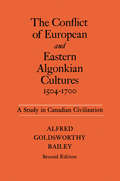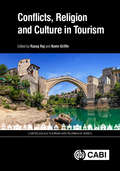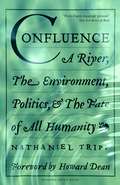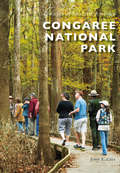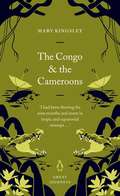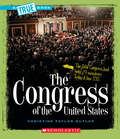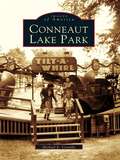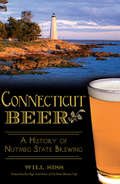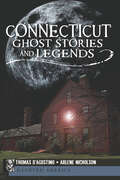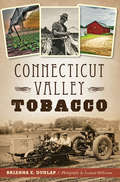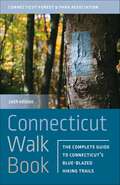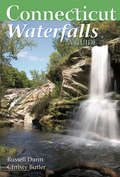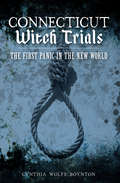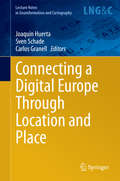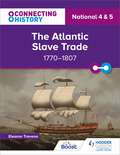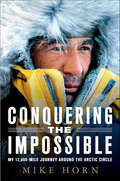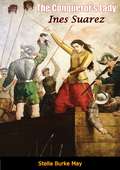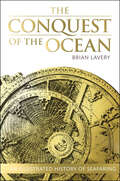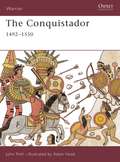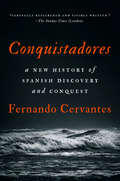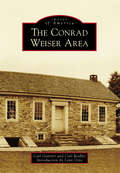- Table View
- List View
The Conflict of European and Eastern Algonkian Cultures, 1505-1700: 2nd Edition
by A. G. BaileyThe movement of one cultural group into the territory of another has always produced conflict: a conflict which is resolved at times by the obliteration of one group, but more often by a gradual fusion of elements drawn from both. This study examines the conflict between the Europeans and the Indians precipitated by the arrival of the French in the New World. The Indians were necessarily affected by the fur trade and the religious and social development of New France, and the meeting of contrary cultures resulted in most cases in the obliteration of that of the Indian. However, a fusion of Indian and European elements sometimes occurred, resulting in the birth of a 'Canadian' culture. The process has been repeated with the immigration of every new cultural group to Canada. This study analyses the conflict and traces the fusion of Canadian culture in its initial stage. First published in 1937, the book has proved an importance contribution to an area of early Canadian history which has been receiving renewed attention. This edition contains the original text with the addition of an index and a new chapter appraising some of the leading developments of the past few years.
Conflicts, Religion and Culture in Tourism (CABI Religious Tourism and Pilgrimage Series)
by Yasin Bilim Ayesha Chowdhury Maite Echarri-Chavez Necmeddin Guney Tinka Delakorda Kawashima Katerina Kikilia Professor Maximiliano Korstanje Lourdes Cisneros Mustellier Dimitrios Mylonopoulos Moira Polyxeni Özgür Özer Balal Qayum Jan Rája Manas Ranjan Sanjeev Singh Kartikeya Sonker Rukeya Suleman Panagiota Vasilopoulou Pierre WiktorinConflicts, Religion and Culture in Tourism highlights the role of religious tourism and pilgrimage as a tool for improving cultural relations. Helping to form culture and society worldwide, faith plays a vital part in cross-cultural conflict resolution and opening dialogue across peoples. This book shows how faith and activism can respond to the common challenges of peace making and coexistence both within and among the world's many traditions. The book: - contains diverse empirical research insights on aspects of religious traditions, conflicts and challenges; - presents a range of contemporary case studies, across ancient, sacred and emerging tourist destinations as well as new forms of pilgrimage, faith systems and quasi-religious activities; - provides a global perspective, including contributions from Europe, Asia and the Americas. Conflicts, Religion and Culture in Tourism provides a timely assessment of the increasing linkages and interconnections between religious tourism and secular spaces on a global stage. Written from a multidisciplinary perspective, it provides an invaluable resource for those studying and researching religion, tourism and cultural management.
Conflicts, Religion and Culture in Tourism
by Razaq Raj Kevin A. GriffinConflicts, Religion and Culture in Tourism highlights the role of religious tourism and pilgrimage as a tool for improving cultural relations. Helping to form culture and society worldwide, faith plays a vital part in cross-cultural conflict resolution and opening dialogue across peoples. This book shows how faith and activism can respond to the common challenges of peace making and coexistence both within and among the world's many traditions. The book: - contains diverse empirical research insights on aspects of religious traditions, conflicts and challenges; - presents a range of contemporary case studies, across ancient, sacred and emerging tourist destinations as well as new forms of pilgrimage, faith systems and quasi-religious activities; - provides a global perspective, including contributions from Europe, Asia and the Americas. Conflicts, Religion and Culture in Tourism provides a timely assessment of the increasing linkages and interconnections between religious tourism and secular spaces on a global stage. Written from a multidisciplinary perspective, it provides an invaluable resource for those studying and researching religion, tourism and cultural management.
Confluence: A River, The Environment, Politics, & The Fate of All Humanity
by Nathaniel TrippAmidst the global free market economy, the author warns us against the politicization of various issues and wants us to look at the larger issues like global warming.
Congaree National Park (Images of Modern America)
by John E. CelyLocated in central South Carolina, only a few miles from the capital city of Columbia, Congaree National Park is the largest old-growth bottomland hardwood forest left in the country and one of the most biologically diverse parks within the national park system. Nearly 100 species of trees have been documented within the park, almost as many as in the entire Pacific Northwest. The park has one of the tallest hardwood forests anywhere in the temperate world and features numerous trees of record-setting proportions, a distinction that has earned it the name �Forest of Champions.� This book discusses the early history of the area that later became the Congaree National Park, shows efforts to protect it from logging by a citizen�s grassroots campaign, traces the park�s early beginnings and development, and illustrates some of the park�s notable flora and fauna.
The Congo and the Cameroons (Great Journeys Ser.)
by Mary KingsleyContemptuous of Europe's 'civilising mission' in Africa, Mary Kingsley's (1862-1900) extraordinary journeys through tropical west Africa are a remarkable record, both of a world which has vanished and of a writer and explorer of immense bravery, wit and humanity. Paddling through mangrove swamps, fending off crocodiles, climbing Mount Cameroon, Kingsley is both admirable and funny.Great Journeys allows readers to travel both around the planet and back through the centuries – but also back into ideas and worlds frightening, ruthless and cruel in different ways from our own. Few reading experiences can begin to match that of engaging with writers who saw astounding things: Great civilisations, walls of ice, violent and implacable jungles, deserts and mountains, multitudes of birds and flowers new to science. Reading these books is to see the world afresh, to rediscover a time when many cultures were quite strange to each other, where legends and stories were treated as facts and in which so much was still to be discovered.
Congo Solo: Misadventures Two Degrees North
by Emily HahnA woman who lived life on her own terms, Hahn was an unknown and struggling writer when Congo Solo was published. Here - restored to the form she had intended - is Hahn's unforgettable narrative, a vivid, provocative, and at times disturbing first-hand account of the racism, brutality, sexism, and exploitation that were everyday life realities under Belgium's iron-fisted colonial rule. Until now, the few copies of Congo Solo in circulation were the adulterated version, which the author altered after pressure from her publisher and threats of litigation from the main character's family. This edition makes available a lost treasure of women's travel writing that shocks and impresses, while shedding valuable light on the gender and race politics of the period.
The Congress of the United States (A True Book (Relaunch))
by Christine Taylor-ButlerLearn the details of the Legislative Branch of governement.A True Book: American History series allows readers to experience the earliest moments in American history and to discover how these moments helped shape the country that it is today. This series includes an age appropriate (grades 3-5) introduction to curriculum-relevant subjects and a robust resource section that encourages independent study.This book describes the legislative branch of the United States government, and discusses each of its two parts, how it works, its origins, and notable events in its history, including impeachments and declarations of war.
Conneaut Lake Park
by Michael E. CostelloIn 1877, a humble boat landing was constucted on Conneaut Lake, Pennsylvania's largest natural lake. Colonel Frank Mantor, a visionary, discovered and purchased the property and convinced investors from the Pittsburgh, Shenango, and Lake Erie Railroad to extend the railroad line to a newly built resort on the site. In 1892, Exposition Park--a permanent fair exhibiting machinery and livestock--was founded. Amusement rides wereadded alongside hotels, cottages, restaurants, and other businesses. The resort grew into an amusement park and was renamed Conneaut Lake Park in 1920. Conneaut Lake Park illustrates the evolution of this lakeside resort with images of long-gone attractions such as the Hotel Elmwood, Temple of Music, Jungle Cruise, Fairyland Forest, and Wild Mouse. Recent favorites such as the Blue Streak, Tumble Bug, Ultimate Trip, and Devil's Den are also included.
Connecticut Beer: A History of Nutmeg State Brewing (American Palate)
by Will Siss Ron PageThe history of the frothy beverage in Connecticut dates back to early colonists, who used it to quench their thirst in the absence of clean drinking water. So integral was beer to daily life in the colony that government officials and militiamen congregated in taverns like the General Wolfe to talk laws and business over pints of ale. Over the next two centuries, the number of breweries rose and then declined, especially after Prohibition. It was not until the 1980s that homebrewers brought this vital Nutmeg State tradition back to life, hatching the likes of New England and Cottrell Brewing Companies, as well as brewpubs including City Steam and Southport Brewing. More recently, small operations with one or two people, such as Relic and Beer'd, are changing the landscape again. Connecticut beer writer Will Siss introduces readers to the hardworking people who keep the breweries and beer bars inviting and the hoppy history alive.
Connecticut Ghost Stories and Legends (Haunted America)
by Thomas D'Agostino Arlene NicholsonThe collaborators of A Guide to Haunted New England track the spirits of the &“Constitution State&” through its storied history. The emerald sheen illuminating the Sabbatarian burying ground, 8 Mile River&’s misty figures which emerge at the Devil&’s Hopyard, and flying demon skeletons on Charles Island—these bizarre haunts are uniquely Connecticut. In the ghostly lore of the state, the ambient ramblings of the Leatherman still ring out in the caves of Harwinton&’s forests and the former residents of the Hale Homestead continue to roam the attic at night. Join authors and Paranormal United Research Founders, Thomas D&’Agostino and his wife Arlene Nicholson, as they recount bone chilling mysteries from Putnam, Canton, New London and many more shadowy corners of the Nutmeg state. Includes photos! Praise for A Guide to Haunted New England &“Fun, charming . . . includes not only locales with reported ghosts, but also sites with macabre (though not haunted) histories.&”—True Crime Librarian &“Anyone interested in exploring the haunted, macabre and abandoned throughout New England knows they can count on D&’Agostino to find out more about the site&’s history, past sightings and how to find them.&”—Mobile RVing
Connecticut Valley Tobacco
by Brianna E. Dunlap Leonard HellermanCigar tobacco runs in the blood of Connecticut River Valley farmers. Delve into the surprising history of the region's most iconic crop, all the way back to early Native American uses and the boom of the Civil War. Though fashionable in the 1950s, the popularity of cigars declined a decade later, nearly destroying the region's tobacco industry. A resurgence in the 1990s brought new life to the crop, and the reopening of Cuba in 2015 added a new chapter for cigar tobacco. Brianna Dunlap, director of the Connecticut Valley Tobacco Museum, provides a guide to important tobacco landmarks from East Haddam to Brattleboro, featuring stunning photography from Leonard Hellerman. It is the story of the people--the farmers and field hands--who made tobacco the soul of the valley.
Connecticut Walk Book: The Complete Guide to Connecticut's Blue-Blazed Hiking Trails
by Connecticut ParkLace up your boots and experience some of the best hiking in New England. Whether you are a day-tripper or long-distance hiker, old hand or novice, you'll find trails suited to every ability and interest. The Connecticut Forest & Park Association (CFPA) maintains over 825 miles of Blue-Blazed Trails in Connecticut, trails that wind through state parks and forests, land trusts, and across private land. The Connecticut Walk Book is a comprehensive guide to these trails, including detailed, full-color maps, mileage/destination tables, and a lay-flat design for ease of use. In this twentieth edition of the Connecticut Walk Book you will find descriptions of the hikes with maps that are clear and easy to read and follow, parking information, and trip-planning essentials that will bring you to every trail.Publication of this book is funded by the Beatrice Fox Auerbach Foundation Fund at the Hartford Foundation for Public Giving.
Connecticut Waterfalls: A Guide
by Russell DunnEasy access to cascades, cataracts, and more. Connecticut is rich in history, geology--and waterfalls.Bringing these together in one guide, richly illustrated by both photographs and antique postcards, this book provides not only good directions and descriptions, but also historic and stratigraphic context for these thrilling yet peaceful places. Many of CT''s waterfalls are now the centerpieces of parks and preserves--perfect for a weekend visit and picnic.
Connecticut Witch Trials: The First Panic in the New World
by Cynthia Wolfe BoyntonThe little-known story of the first witch hunt in New England—nearly half a century before Salem. Connecticut&’s witch hunt was the first and most ferocious in New England, occurring almost fifty years before the infamous Salem witch trials. Between 1647 and 1697, at least thirty-four men and women from across the state were formally charged with witchcraft. Eleven were hanged. In New Haven, William Meeker was accused of cutting off and burning his pig&’s ears and tail as he cast a bewitching spell. After the hanging of Fairfield&’s Goody Knapp, magistrates cut down and searched her body for the marks of the devil. In this book, through newspaper clippings, court records, letters, and diaries, former New York Times correspondent Cynthia Wolfe Boynton uncovers the dark history of the Connecticut witch trials. Includes illustrations
Connecting a Digital Europe Through Location and Place (Lecture Notes in Geoinformation and Cartography)
by Joaquín Huerta Sven Schade Carlos GranellThis book collects innovative research presented at the 17th Conference of the Association of Geographic Information Laboratories for Europe (AGILE) on Geographic Information Science, held in 2014 in Castellón, Spain. The scientific papers cover a variety of fundamental research topics as well as applied research in Geospatial Information Science, including measuring spatiotemporal phenomena, crowdsourcing and VGI, geosensor networks, indoor navigation, spatiotemporal analysis, modeling and visualization, spatiotemporal decision support, digital earth and spatial information infrastructures. The book is intended for researchers, practitioners, and students working in various fields and disciplines related to Geospatial Information Science and technology.
Connecting History: National 4 & 5 The Atlantic Slave Trade, 1770–1807
by Eleanor TrevenaExam board: SQALevel: National 4 & 5Subject: HistoryFirst teaching: September 2017First assessment: Summer 2018Fresh stories, fresh scholarship and a fresh structure. Connecting History informs and empowers tomorrow's citizens, today.Bringing together lesser-told narratives, academic excellence, accessibility and a sharp focus on assessment success, this series provides a rich, relevant and representative History curriculum.> Connect the past to the present. Overarching themes of social justice, equality, change and power help students to understand the importance of events and issues, then and now.> Go far beyond other resources. With respect and aspiration for the transformative power of History, this series incorporates the latest research, challenges old interpretations and embeds diverse experiences throughout.> Follow a clear and consistent structure. The key issues in the N5 specification form the chapters in each book, and the content descriptors are subheadings within the chapters. Finding the information that you need has never been easier.> Meet the demands of the assessments. Connecting History develops the knowledge and skills for success, with appropriate breadth, depth and pace. The narrative and sources take centre stage and the authors model the process of answering questions effectively through that narrative, ensuring that students know all the key points that they need to. End-of-chapter activities consolidate and extend learning.> Benefit from pedagogic and academic expertise. The authors are highly experienced teachers and examiners who know how to spark critical curiosity in students. Each book has been rigorously reviewed by an academic from the University of Glasgow, so you can rest assured that the content is accurate and up to date.
Connecting History: National 4 & 5 The Atlantic Slave Trade, 1770–1807
by Eleanor TrevenaExam board: SQALevel: National 4 & 5Subject: HistoryFirst teaching: September 2017First assessment: Summer 2018Fresh stories, fresh scholarship and a fresh structure. Connecting History informs and empowers tomorrow's citizens, today.Bringing together lesser-told narratives, academic excellence, accessibility and a sharp focus on assessment success, this series provides a rich, relevant and representative History curriculum.> Connect the past to the present. Overarching themes of social justice, equality, change and power help students to understand the importance of events and issues, then and now.> Go far beyond other resources. With respect and aspiration for the transformative power of History, this series incorporates the latest research, challenges old interpretations and embeds diverse experiences throughout.> Follow a clear and consistent structure. The key issues in the N5 specification form the chapters in each book, and the content descriptors are subheadings within the chapters. Finding the information that you need has never been easier.> Meet the demands of the assessments. Connecting History develops the knowledge and skills for success, with appropriate breadth, depth and pace. The narrative and sources take centre stage and the authors model the process of answering questions effectively through that narrative, ensuring that students know all the key points that they need to. End-of-chapter activities consolidate and extend learning.> Benefit from pedagogic and academic expertise. The authors are highly experienced teachers and examiners who know how to spark critical curiosity in students. Each book has been rigorously reviewed by an academic from the University of Glasgow, so you can rest assured that the content is accurate and up to date.
Conquering the Impossible: My 12,000-Mile Journey Around the Arctic Circle
by Mike HornIn August 2002, Mike Horn set out on a mission that bordered on the impossible: to travel 12,000 miles around the globe at the Arctic Circle - alone, against all prevailing winds and currents, and without motorized transportation.Conquering the Impossible is the gripping account of Horn's grueling 27-month expedition by sail and by foot through extreme Arctic conditions that nearly cost him his life on numerous occasions. Enduring temperatures that ranged to as low as -95 degrees Fahrenheit, Horn battled hazards including shifting and unstable ice that gave way and plunged him into frigid waters, encounters with polar bears so close that he felt their breath on his face, severe frostbite in his fingers, and a fire that destroyed all of his equipment and nearly burned him alive.Complementing the sheer adrenaline of Horn's narrative are the isolated but touching human encounters the adventurer has with the hardy individuals who inhabit one of the remotest corners of the earth. From an Inuit who teaches him how to build an igloo to an elderly Russian left behind when the Soviets evacuated his remote Arctic town, Horn finds camaraderie, kindness, and assistance to help him survive the most unforgiving conditions.This awe-inspiring account is a page-turner and an Arctic survival tale in one. Most of all, it's a testament to one man's unrelenting desire to push the boundaries of human endurance.
The Conqueror's Lady: Ines Suarez
by Stella Burke MayFascinating biography of Spanish Conquistador, Ines Suarez recounting her life and adventures in South America.“On a morning in January, 1540, an army of one hundred and seventy Spanish soldiers, commanded by Pedro de Valdivia, departed from Cuzco, Peru, to conquer the land called Chile.One Spanish woman accompanied them. Her name was Ines Suarez.More than a year later, the gaunt remnants of that little army clambered up the solitary rock that the Indians called Huelen (Sorrow) and which today is known as the Cerro Santa Lucia, and took possession of Chile in the name of God and of Charles the Fifth, of Spain.”—Introduction
The Conquest of the Ocean: An Illustrated History of Seafaring (DK Short Histories)
by Brian LaveryA captivating tale spanning 5,000 years of the oceans' history, The Conquest of the Ocean tells the stories of the remarkable individuals who sailed seas, for trade, to conquer new lands, to explore the unknown. From the early Polynesians to the first circumnavigations by the Portuguese and the British, these are awe-inspiring tales of epic sea voyages involving great feats of seamanship, navigation, endurance, and ingenuity. Explore the lives and maritime adventures, many with first-person narratives of land seekers and globe charters such as Christopher Columbus, Captain James Cook, and Vitus Bering.
Conquista!
by Clyde Robert Bulla Michael SysonAt the time of Coronado exploration for a fabled city of gold, a young Indian boy encounters his first horse.
The Conquistador
by John Pohl Adam HookMany accounts portray the conquest of the New World as a remarkable military achievement, with Cortés' vastly outnumbered but better armed Spaniards defeating hordes of superstitious savages. However, the reality of these events is far more complex and no less significant. The first Conquistadors who had sailed in search of prosperity, inspired by dreams of unlimited riches, soon became disillusioned and restless. With disease rampant, resources exhausted, and the Caribbean populations dwindling, they had little alternative but to find new territories and peoples to exploit. This title shows how, bolstered by influxes of war-hardened veterans from Europe and an army of over 30,000 allied Indian troops, they came to rely on and perfect what they knew best - killing for profit, and without mercy.
Conquistadores: A New History of Spanish Discovery and Conquest
by Fernando CervantesA sweeping, authoritative history of 16th-century Spain and its legendary conquistadors, whose ambitious and morally contradictory campaigns propelled a small European kingdom to become one of the formidable empires in the world &“The depth of research in this book is astonishing, but even more impressive is the analytical skill Cervantes applies. . . . [He] conveys complex arguments in delightfully simple language, and most importantly knows how to tell a good story.&” —The Times (London) Over the few short decades that followed Christopher Columbus's first landing in the Caribbean in 1492, Spain conquered the two most powerful civilizations of the Americas: the Aztecs of Mexico and the Incas of Peru. Hernán Cortés, Francisco Pizarro, and the other explorers and soldiers that took part in these expeditions dedicated their lives to seeking political and religious glory, helping to build an empire unlike any the world had ever seen. But centuries later, these conquistadors have become the stuff of nightmares. In their own time, they were glorified as heroic adventurers, spreading Christian culture and helping to build an empire unlike any the world had ever seen. Today, they stand condemned for their cruelty and exploitation as men who decimated ancient civilizations and carried out horrific atrocities in their pursuit of gold and glory. In Conquistadores, acclaimed Mexican historian Fernando Cervantes—himself a descendent of one of the conquistadors—cuts through the layers of myth and fiction to help us better understand the context that gave rise to the conquistadors' actions. Drawing upon previously untapped primary sources that include diaries, letters, chronicles, and polemical treatises, Cervantes immerses us in the late-medieval, imperialist, religious world of 16th-century Spain, a world as unfamiliar to us as the Indigenous peoples of the New World were to the conquistadors themselves. His thought-provoking, illuminating account reframes the story of the Spanish conquest of the New World and the half-century that irrevocably altered the course of history.
Conrad Weiser Area, The
by Carl Ganster Lynn Otto Carl ReidlerIn 1729, John Conrad Weiser, the most famous citizen of the area, joined his fellow Germans and built his homestead just east of present-day Womelsdorf. The settlement grew in the 1800s with a turnpike, a canal, a railroad, and more highways. Villages were started, and three became boroughs. Womelsdorf is the oldest borough in the western part of Berks County, while Robesonia and Wernersville were railroad towns laid out in the 1850s. Some remain villages to this day. Stouchsburg grew up around the turnpike and the canal. Charming Forge was the first industry in the area, and the village still looks like it did 200 years ago. The remaining parts of the area are rural, and some of the best growing soil is found in the Conrad Weiser area. In 1954, seven municipalities joined to form the Conrad Weiser Area School District. This book covers photographs from 1900 until the 1960s and includes all municipalities.
